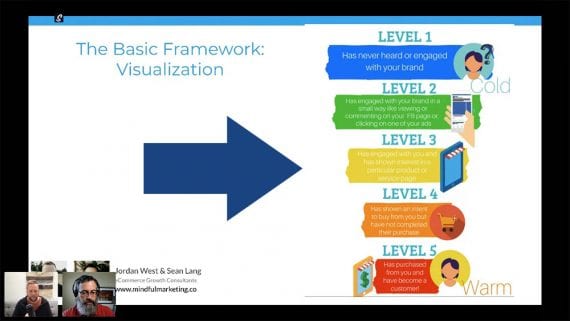“This list was barely 2,000 subscribers at this point, but I wanted to show you how incredibly effective SMS marketing is even when you are starting,” said West as he displayed results from five SMS marketing campaigns that had generated more than ,000 in sales.
“Think about it like this. If you meet someone…[the relationship] starts small, asking for small things. You’re not asking someone for her phone number immediately. That’s a big thing with SMS. Don’t try and get everybody on your list.”
Don’t Invite Everyone
West recommends segmenting customers by what he calls “traffic level.” The idea is to create segments around the depth of customer relationships. Purchasers are a different segment than first-time visitors.
Text messaging can be among the most productive retail marketing channels, provided the workflows are automated and the performance is tracked.
One of the key benefits of digital marketing is automation. A business can set up programmatic workflows that encourage and move customers and prospects along the purchase process and into a deeper level of engagement.
As with nearly any marketing channel, the metrics your business tracks should be related to the goals for that campaign. West wants sales, so click-through rate, conversion rate, and revenue-per-message are all critical.

Entrepreneur Jordan West, the owner of an ecommerce agency, Mindful Marketing, and an online apparel company, The Kindred Studio, uses text-message marketing to drive customer engagement and sales. He believes text messages are among his best marketing channels.
“Look at this click-through rate: 43% percent. And a 10% conversion rate after that. So .11 per message,” said West as he was sharing some of his own company’s SMS marketing data during a live event for the CommerceCo by Practical Ecommerce community.
Automate
West, for example, uses automation to achieve strong SMS results. In this way, his approach to SMS was similar to the way many successful commerce businesses use email marketing or even social media marketing. Those businesses segment, target, and personalize messages.
“So that message is costing me one penny, and I’m getting .11 in revenue per message. That’s astounding,” West said of his company’s welcome series SMS automation. “The abandoned cart [SMS automation] is even bigger, .26 per message.”
Rather, focus text-message marketing on those customer segments most likely to respond to text campaigns.
Measure
“Have you ever heard of the term ‘spray and pray’ marketing?” asked West. “Don’t do this. Don’t treat all customers the same. Each customer has a unique relationship with your brand. Don’t disrespect them by treating them all the same.
Text-message marketing is trackable and measurable. While West was quick to point out that attribution is not always clear with SMS, he also took pains to explain how to measure it. For your business, identify levels of customer connectedness, if you will. West has a numbered scale for this. Other marketers might use the recency, frequency, monetary value (RFM) model to identify the proper spot in a relationship to ask a customer if you can send promotional text messages.

List Size
West has developed a framework to segment shoppers based on their relationship to the company. The framework moves prospects from cool to warm leads.
One metric you may not want to measure, especially when you’re just beginning with text-message marketing, is the number of subscribers.
Instead, focus on results — advancing consumer relationships and generating sales.






